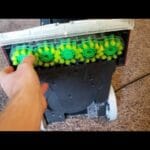Are you frustrated because your refrigerator’s compressor is running, but the fridge isn’t cooling? You’re not alone.
Many people face this issue and wonder what’s gone wrong. You rely on your refrigerator to keep your food fresh and safe. When it fails, it can disrupt your daily routine and lead to waste. Imagine opening your fridge for a cold drink or a fresh meal and finding everything warm.
Not only is it inconvenient, but it can also be costly. This problem can be solved, and you’re about to learn how. Dive into this article to uncover why your refrigerator might be acting up and discover simple solutions to get it back on track. Your fridge’s cooling woes can be a thing of the past. Keep reading, and soon you’ll have your refrigerator running smoothly again.
Common Causes Of Cooling Issues
Refrigerators are essential for keeping food fresh and safe. Sometimes, though, they don’t cool properly even if the compressor runs. Understanding the common causes of these cooling issues can help you fix the problem. It also ensures that your fridge works efficiently. Let’s explore some frequent reasons why your refrigerator might not cool.
Thermostat Malfunction
The thermostat regulates the fridge’s temperature. A faulty thermostat can cause cooling issues. It may not send the correct signals to the compressor. This leads to improper cooling. Check if the temperature settings are correct. Adjust them as needed. If the issue persists, consider replacing the thermostat.
Blocked Vents
Vents allow cold air to circulate inside the fridge. Blocked vents restrict airflow and cause uneven cooling. Check if items in the fridge block these vents. Rearrange items to ensure free airflow. Keep the vents clear for optimal cooling.
Dirty Condenser Coils
Condenser coils release heat from the fridge. Dust and dirt can accumulate on these coils. This buildup hampers their efficiency. Dirty coils make the compressor work harder. This can lead to cooling problems. Regularly clean the coils to maintain proper cooling. Use a brush or vacuum for this task. It keeps your fridge running smoothly.

Credit: www.youtube.com
Checking The Thermostat
A refrigerator compressor running but not cooling can be frustrating. One common issue is a faulty thermostat. The thermostat controls the temperature inside your fridge. If it malfunctions, your fridge might not cool properly. Checking and adjusting the thermostat is essential. Let’s explore how to do this effectively.
Adjusting Temperature Settings
Start by examining the temperature settings. The dial or digital display should be easy to locate. Ensure it’s set to the correct cooling level. Sometimes, accidental bumps can change the settings. Adjusting it back can solve cooling issues.
Set the temperature to the middle range. This range is usually ideal for optimal cooling. Allow a few hours for the temperature to stabilize. Check the settings again if the cooling issue persists.
Testing Thermostat Functionality
If adjusting the settings doesn’t help, the thermostat may be faulty. Testing its functionality is crucial. Unplug the fridge before starting. Locate the thermostat, usually found inside the fridge.
Use a multimeter to test the thermostat. Set it to the lowest resistance setting. Place the multimeter probes on the thermostat terminals. A reading of zero or near zero indicates functionality.
No reading? The thermostat might be faulty. Consider replacing it to restore the fridge’s cooling ability.
Inspecting Airflow
Experiencing a refrigerator compressor running but not cooling can be frustrating. Understanding the root cause is crucial. One common issue is poor airflow. Airflow helps maintain the right temperature inside. Blockages or circulation problems can lead to inefficient cooling.
Clearing Vent Blockages
Check for obstructions in the vents. Food items, dust, or debris can block air passage. These blockages prevent the cold air from circulating. Remove any items that block the vents. Regular cleaning keeps the vents clear. Use a soft brush to clean dust or debris.
Ensuring Proper Circulation
Proper circulation is vital for cooling efficiency. Make sure shelves are not overcrowded. Overloading shelves restricts air movement. Arrange items to allow space for air to circulate. Keep larger items away from the vents. This simple step can enhance the cooling performance.
Cleaning Condenser Coils
Cleaning condenser coils can resolve cooling issues when the refrigerator compressor runs but doesn’t cool. Dust and debris block airflow, causing inefficient cooling. Regular maintenance ensures the coils stay clear, enhancing performance.
Cleaning the condenser coils of your refrigerator can solve cooling problems. Dirty coils cause the compressor to work harder. This can lead to overheating and reduced cooling efficiency. Regular cleaning keeps your fridge working well. It also extends the lifespan of your appliance. Let’s explore how to locate and clean these coils effectively.Locating The Coils
Condenser coils are often found at the back or bottom of the fridge. Check your user manual for precise details. If your fridge has a grill or panel, remove it carefully. This will give you access to the coils.Steps For Cleaning
First, unplug the refrigerator to ensure safety. Use a vacuum cleaner to remove loose dirt and dust. A coil brush helps reach tight spaces. Brush gently to avoid damaging the coils. Next, wipe with a damp cloth to remove stubborn grime. Ensure the coils are dry before plugging the fridge back in. Regular cleaning improves cooling and efficiency.Examining The Compressor
A refrigerator compressor running but not cooling can signal a problem. It might be due to a faulty start relay or issues with the evaporator coils. Addressing these can restore cooling efficiency, ensuring your food stays fresh.
When your refrigerator’s compressor is running but not cooling, it can feel like a mystery begging to be solved. The compressor is the heart of your refrigerator, and when it’s not doing its job, your food might spoil faster than anticipated. Understanding how to examine your compressor can save you both time and money, and possibly even your groceries.Signs Of Compressor Failure
How can you tell if your compressor is failing? One clear sign is unusual noises. If your compressor is buzzing louder than usual or making clanking sounds, it might be struggling. Another sign is the compressor being hot to the touch, indicating it’s overworking. You may also notice your refrigerator isn’t as cold as it should be, even though the compressor seems to be running. This could mean that the internal components of the compressor are failing. Have you checked for frost buildup? A failing compressor can lead to this issue, affecting the cooling efficiency.Professional Repair Options
Have you considered calling in a professional? When your compressor is on the fritz, sometimes the best course of action is seeking expert help. A qualified technician can diagnose the problem accurately, ensuring you don’t waste money on unnecessary repairs. Professional repairs might include fixing internal leaks, replacing faulty parts, or even installing a new compressor. Wondering about the cost? While it might seem like a significant expense, remember that a well-functioning refrigerator saves on energy bills and keeps your food fresh. Taking proactive steps when examining your compressor can prevent further issues. Have you experienced any other symptoms of compressor failure? Share your experience or ask questions in the comments below.
Credit: www.youtube.com
Evaluating The Evaporator Fan
Checking the evaporator fan is crucial if the refrigerator compressor is running but not cooling. The fan helps circulate cold air throughout the fridge. A faulty fan can lead to uneven cooling and warm spots.
Is your refrigerator compressor humming away, but the fridge remains stubbornly warm? You might be dealing with an evaporator fan issue. This fan plays a crucial role in circulating cool air throughout your refrigerator. If it’s not functioning properly, your fridge may not cool effectively. Let’s dive into how you can assess the evaporator fan’s condition and what steps to take if it’s faulty.Fan Functionality Issues
Your evaporator fan needs to spin freely to distribute cold air. If it’s stuck or spinning slowly, cooling efficiency drops. Listen for odd noises like rattling or grinding; they may indicate worn bearings. You might also notice inconsistent cooling with certain areas colder than others. Dust and debris can clog the fan blades. A simple cleaning might restore its function. Before cleaning, ensure the fridge is unplugged to avoid accidents. Is the fan motor getting power? Use a multimeter to check. If power is present but the fan doesn’t spin, the motor might be faulty.Replacement Guidelines
A faulty fan often requires replacement. Don’t worry; it’s a manageable task. First, consult your refrigerator’s manual for specific part numbers. This ensures you get the right replacement. Gather the necessary tools. A screwdriver set is usually sufficient. You might need a socket wrench for some models. Remember to unplug your fridge. Safety first! Remove the back panel inside the freezer to access the fan. Carefully disconnect the wires and unscrew the fan assembly. Install the new fan by reversing the removal process. Ensure all screws and connections are secure. Plug the fridge back in and listen for the fan. It should now run smoothly, restoring your refrigerator’s cooling prowess. Have you ever tackled a DIY appliance repair? Share your experiences or questions in the comments. Your insights could help others facing similar cooling conundrums.Assessing Door Seals
Checking door seals can solve cooling issues when the refrigerator compressor runs. Damaged seals let cold air escape, reducing efficiency. Replacing faulty seals restores proper cooling, enhancing refrigerator performance.
A refrigerator that runs but doesn’t cool can be frustrating, especially when you open the door expecting a cold drink or fresh groceries. One common culprit could be faulty door seals. A compromised seal allows cold air to escape, making the compressor work overtime without any cooling effect. Assessing door seals can be a straightforward DIY task that might just save you a service call. Let’s dive into how you can check and fix these seals to restore your fridge’s functionality.Seal Integrity Check
The integrity of the door seals is crucial for maintaining a consistent internal temperature. Start by running your fingers along the edges of the seals. Can you feel any cracks or gaps? If yes, that might be where the cold air is sneaking out. Another simple trick is the paper test. Close the refrigerator door on a piece of paper and try to pull it out. If it slides out easily, your seal might not be doing its job. Check for moisture accumulation or mold, which can indicate a breach. Sometimes, the seals might just be dirty, preventing a snug fit. A quick clean could work wonders.Repairing Or Replacing Seals
If your seals are damaged or loose, you might need to repair or replace them. Tighten any loose areas by gently heating them with a hairdryer and reshaping the seal. Be careful not to overheat, which can cause further damage. For worn-out seals, consider replacing them. Most hardware stores carry replacement seals, and they often come with easy-to-follow instructions. Ensure you have your refrigerator’s model number handy to get the correct size. Can’t find the right replacement? Check online retailers or your refrigerator’s manufacturer website. The effort is worth it to keep your food fresh and your energy bills down. Do you find yourself frequently adjusting the fridge settings to compensate for cooling issues? It might be time to give those seals a thorough check. A simple fix could save you from a costly repair.
Credit: www.ifixit.com
Checking Refrigerant Levels
When your refrigerator’s compressor is running but the appliance isn’t cooling, checking the refrigerant levels could be your next step. This might seem like a job for the pros, but understanding how to identify and address refrigerant issues can save you time and money. Let’s dive into how you can check and manage refrigerant levels to get your refrigerator back to optimal performance.
Identifying Leaks
Before you add more refrigerant, it’s crucial to identify if there’s a leak. Inspect the coils and connecting tubes for any oily residue. This residue often signals a refrigerant leak.
Listen closely for any hissing sounds, which might indicate a puncture or crack. A leak left unattended can lead to inefficient cooling, higher energy bills, or even complete system failure.
Have you noticed an increase in your electricity bill? A leak might be the culprit. Addressing it promptly can prevent further damage.
Refilling Refrigerant
Once you’ve identified and fixed any leaks, it’s time to refill the refrigerant. Ensure you use the correct type of refrigerant specified in your refrigerator’s manual. Using the wrong type can cause damage to the compressor.
Follow the instructions carefully to avoid overfilling. Overfilling can put extra stress on the compressor, leading to more problems down the line.
If this sounds overwhelming, don’t hesitate to call a professional. It’s better to be safe than sorry when dealing with refrigerants. Have you tried refilling refrigerant before? Share your experience and tips with others in the comments below!
Preventive Maintenance Tips
Experiencing a running refrigerator compressor but no cooling? Check for blocked vents and dirty coils. Clean regularly to prevent airflow issues and ensure efficient cooling. Regular maintenance extends the lifespan of your appliance.
A refrigerator not cooling can disrupt your daily routine, but with preventive maintenance, you can avoid this inconvenience. Regular attention to your refrigerator can keep it running efficiently and extend its lifespan. These simple preventive tips can help you catch potential issues before they become bigger problems.Regular Cleaning Routine
Dust and debris can accumulate on the refrigerator coils, reducing efficiency. Make it a habit to clean these coils at least twice a year. Use a vacuum or a coil brush to remove the build-up easily. Inside the fridge, check for expired items and spills. Keeping the interior clean ensures proper airflow and reduces the strain on the compressor. A clutter-free fridge is not only hygienic but also energy-efficient.Periodic Professional Inspections
Even with regular cleaning, some issues might not be visible. Scheduling professional inspections annually can uncover hidden problems. Technicians can check the refrigerant levels and inspect the compressor and other components. They have the expertise to spot potential issues that might not be obvious to you. Consider it an investment in your appliance’s longevity. Wouldn’t you rather pay a small inspection fee than replace a costly unit? Being proactive with these preventive tips means fewer surprises. Your refrigerator will thank you with consistent cooling and energy savings. What steps will you take today to ensure your fridge runs smoothly tomorrow?Frequently Asked Questions
Why Is My Fridge Compressor Running But Not Cooling?
Your fridge might have a blocked airflow. Check vents and clean the coils.
How Can I Fix A Non-cooling Refrigerator?
Check door seals. Ensure they’re tight. Clean condenser coils. This can improve cooling.
What Causes Refrigerator Cooling Issues?
Dirty coils and faulty fans often cause cooling problems. Regular maintenance helps.
Is It Safe To Keep Food In A Fridge Not Cooling?
No. Food may spoil quickly. Use a cooler for temporary storage.
Should I Call A Professional For Fridge Cooling Problems?
Yes, if basic checks fail. A professional can diagnose and fix complex issues.
Conclusion
A refrigerator running but not cooling can be frustrating. Check simple things first. Make sure the door seals tightly. Clear any vents blocked by food. Listen for odd noises from the compressor. Clean coils can improve cooling. If problems persist, consider calling a technician.
Regular maintenance keeps your fridge efficient. Small fixes often solve big issues. Remember, a well-kept fridge saves energy. Keep food safe and fresh by ensuring it cools properly. Troubleshoot smartly and enjoy peace of mind. Keep your refrigerator in top shape with these tips.




